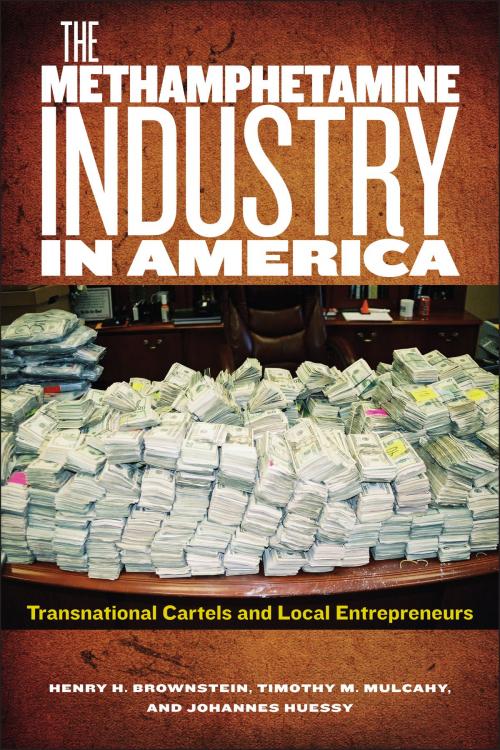The Methamphetamine Industry in America
Transnational Cartels and Local Entrepreneurs
Nonfiction, Health & Well Being, Self Help, Addiction, Drug Dependence, Social & Cultural Studies, Social Science, Crimes & Criminals, Criminology, Sociology| Author: | Henry H Brownstein, Timothy M. Mulcahy, Johannes Huessy | ISBN: | 9780813574561 |
| Publisher: | Rutgers University Press | Publication: | July 31, 2014 |
| Imprint: | Rutgers University Press | Language: | English |
| Author: | Henry H Brownstein, Timothy M. Mulcahy, Johannes Huessy |
| ISBN: | 9780813574561 |
| Publisher: | Rutgers University Press |
| Publication: | July 31, 2014 |
| Imprint: | Rutgers University Press |
| Language: | English |
Galax, a small Virginia town at the foot of the Blue Ridge Mountains, was one of the first places that Henry H. Brownstein, Timothy M. Mulcahy, and Johannes Huessy visited for their study of the social dynamics of methamphetamine markets—and what they found changed everything. They had begun by thinking of methamphetamine markets as primarily small-scale mom-and-pop businesses operated by individual cooks who served local users—generally stymied by ever more strenuous laws. But what they found was a thriving and complex transnational industry. And this reality was repeated in towns and cities across America, where the methamphetamine market was creating jobs and serving as a focus for daily lives and social experience.
The Methamphetamine Industry in America describes the reality that the methamphetamine industry is a social phenomenon connecting local, national, and international communities and markets. The book details the results of a groundbreaking three-stage study, part of a joint initiative of the National Institute on Drug Abuse and the National Institute of Justice, in which police agencies across the United States were surveyed and their responses used to identify likely areas of study. The authors then visited these areas to observe and interview local participants, from users and dealers to law enforcement officers and clinical treatment workers.
Through the eyes and words of these participants, the book tells the story of the evolution of methamphetamine markets in the United States over the past several years, given changes in public policies and practices and changing public opinion about methamphetamine. The authors look closely at how the markets are part of a larger industry, how they are socially organized, and how they operate. They also consider the relationships among the people involved and those around them, and the national, regional, and local culture of the markets. Their work demonstrates the importance of understanding the business of methamphetamine—and by extension other drugs in society—through a lens that focuses on social behavior, social relationships, and the cultural elements that shape the organization and operation of this illicit but effective industry.
Galax, a small Virginia town at the foot of the Blue Ridge Mountains, was one of the first places that Henry H. Brownstein, Timothy M. Mulcahy, and Johannes Huessy visited for their study of the social dynamics of methamphetamine markets—and what they found changed everything. They had begun by thinking of methamphetamine markets as primarily small-scale mom-and-pop businesses operated by individual cooks who served local users—generally stymied by ever more strenuous laws. But what they found was a thriving and complex transnational industry. And this reality was repeated in towns and cities across America, where the methamphetamine market was creating jobs and serving as a focus for daily lives and social experience.
The Methamphetamine Industry in America describes the reality that the methamphetamine industry is a social phenomenon connecting local, national, and international communities and markets. The book details the results of a groundbreaking three-stage study, part of a joint initiative of the National Institute on Drug Abuse and the National Institute of Justice, in which police agencies across the United States were surveyed and their responses used to identify likely areas of study. The authors then visited these areas to observe and interview local participants, from users and dealers to law enforcement officers and clinical treatment workers.
Through the eyes and words of these participants, the book tells the story of the evolution of methamphetamine markets in the United States over the past several years, given changes in public policies and practices and changing public opinion about methamphetamine. The authors look closely at how the markets are part of a larger industry, how they are socially organized, and how they operate. They also consider the relationships among the people involved and those around them, and the national, regional, and local culture of the markets. Their work demonstrates the importance of understanding the business of methamphetamine—and by extension other drugs in society—through a lens that focuses on social behavior, social relationships, and the cultural elements that shape the organization and operation of this illicit but effective industry.















